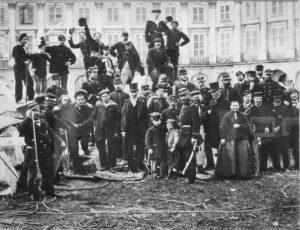CLICK your fingers. Click them again. Watch. The sound – the click – isn’t produced by two fingers rubbing each other, but by your middle finger hitting your palm, making contact. Now try to make a click without hitting your palm. What do you hear? An annoying, quiet, ineffectual scratching.
CLICK CLICK—two tweets blow out neoliberalism’s candle. “It is the end of an era, the era of neoliberalism. We don’t yet know what will succeed it,” wrote Gérard Araud, French ambassador to the U.S., after Trump’s win.

“Their world is collapsing. Ours is being built,” wrote Florian Philippot of Front National (FN), Marine Le Pen’s strategist. Question: Did his finger pause for a second? Before sending that tweet—did now we’re taking back control tick across his mind?
The two tweets and the two Frenchmen were right and wrong. Right: one variety of neoliberalism is waning. Wrong: we do know what comes next. Violence—a mutation of neoliberalism into a more violent form: violent liberalism, or vio-liberalism.
CLICK CLICK CLICK. A finger click takes the same time as pressing that magic blue button: ‘Tweet’—a bordered space we push to send out fractal birdsongs of love, or terror. And according to a new study, far-right terror is out-performing ISIS, with the number of white nationalists and self-identified Nazi sympathisers on Twitter multiplying by 600%.
There’s the problem. The Right is clicking and connecting, the Left merely scratching.
Dog whistle politics
The first violiberal tone is a high-pitched whistle, and let’s be clear: Trump used dog whistles to win the U.S. election. Dog whistles are coded messages – colour-blind on the surface – but in reality a red rag to certain white voters. When Trump says “inner cities”, he means poor, crime-ridden places where black people live—ignoring the truth that more African-Americans now live in suburbs than cities. When he says “immigration” he means poor, minority immigrants, primarily Mexicans, despite U.S. government figures showing India and China ahead of Mexico as countries of origin. When he spoke of “global special interests” he meant Jews, the scapegoat of ages. Trump dog-whistled, and white voters – male and female – pricked up their ears, listened, and scampered to the polling booth.
Dog whistle politics distort democracy. As Ian Haney López writes in his 2014 book How Coded Racial Appeals Have Reinvented Racism and Wrecked the Middle Class, this instrumental use of race – and dog whistles primarily concern race – “constitutes the dark magic by which middle-class voters have been convinced to turn government over to the wildly affluent”. According to López, dog whistle politics causes middle-class whites to vote against their own interests, further entrenching the destructive policies of corporations stripping jobs and hollowing out their towns. This is voter self-harm on an epic scale.
But dog whistles only explain part of the story. We need to ask how dog whistles found a receptive audience. To answer that we need to look at the media, or today’s media minefield.

According to George Gerbner, who researched television’s impact on American minds for fifty years, the media works by cultivation. The cumulative effect of the media cultivates a worldview; and Gerbner called this worldview the ‘Mean World Syndrome’. He found that people who watched a lot of television saw the world as frightening and forbidding—full of threats. People with this worldview then demand protection and strong action against these threats: more police, more prisons. This sense of threat also leads people to arm themselves: America has enough guns in circulation for every man, woman and child, with U.S. gun-makers producing nearly 11 million guns in 2013. Yet this behaviour comes in the middle of what people call the Great Crime Decline. According to one recent article, “Americans now live in one of the least violent times in the nation’s history.”
Gerbner also studied the media portrayal of minorities. Latinos were under-represented on television compared to population size, and shown as violent or untrustworthy. Black people were portrayed in two contrasting ways: more successful than whites – firmly middle-class (think The Cosby Show) – or as violent criminals. As a result, white people receive an extremely distorted view of Black and Latino people; a parallax view whipped up by far-right media organisation Breitbart, the so-called Pravda of the alt-right—the Promethean swamp behind Trump. They topped the ‘Mean World Syndrome’ by a mile, giving people ‘suffering’ under the yoke of political correctness a new matrix of understanding: ‘Persecuted World Syndrome’. In Breitbart’s persecuted world, whites are victims of black, feminist, and liberal oppression—liberals lie around each corner, with their femo-liberal, bleeding-heart, LGBT tweets.
Yet Breitbart and Trump, at root, symbolise the politics of frustration—the feeling others are jumping the queue for the American Dream. In Ur-Fascism, a 1995 New York Times essay, Umberto Eco wrote that “fascism was the appeal to a frustrated middle class, a class suffering from an economic crisis or feelings of political humiliation, and frightened by the pressure of lower social groups”. Eco predicated “the fascism of tomorrow will find its audience in this new majority”. Although Trump had support in the deindustrialised rust belt, exit polls show college-educated whites won Trump the election, not working-class whites.
People live in fear and want explanations and answers—the Right provides them. The Right is making contact, collecting clicks, dragging us into a violent future—a future laid out for us by racist dog whistles; by neoliberal economic policies which have decimated people’s towns and lives; policies more punitive with each consecutive crisis. And the Ur-Policy of choice?
Austerity cuts and clicks
Austerity is the Ur-Policy of choice; ‘Nightmare on Austerity Street’ the slasher film in permanent production—with no intervals, no refunds, and no ice cream. In the face of such austerity-horror – aust-horrity – we remain quiet: No screaming while the bus is in motion! Cheap to produce and highly potent, austerity is the amniotic fluid of choice—the unquestioned medium in which we swim, or sink.
Vickie Cooper, co-editor with David Whyte of The Violence of Austerity (due out 2017), explains UK austerity policies as a form of institutional violence which, when embedded in institutions become “mundane and everyday”. And the state, the once social-democratic state, enacts the violence:
“We live in a political system that makes key decisions that affect the life chances of its citizens, and the only reason that the state is able to have such a violent impact is the nature of this deeply entrenched and expansive bureaucracy; a historically developed architecture of power. This same architecture of power that erected the welfare state and the National Health Service is now able to bring them down.”

The transformation of the social-democratic bureaucracy into a vio-liberal bureaucracy is curious—curious because bureaucracy, in the twentieth century, became a punch bag for the right. Arch-neoliberal Ludwig von Mises, in his 1944 book Bureaucracy, claimed socialist bureaucrats “plan to transform the world into a gigantic post office.” (Remember the German Post Office was the 19th-century’s gift to efficiency.) Yet today’s state bureaucrats seem happy remaking the world into a gigantic safari park of the poor and vulnerable. Just as the Victorians liked to tour lunatic asylums, we hunger for ‘poverty porn’—poverty as entertainment hiding the institutional violence at work.
Austerity’s knife slices along society’s stretched skin—following lines drawn on the social body by austerity’s surgeons; lines indicating where the knife falls and cuts belong. And it’s under that knife that the vulnerable cower, dwelling at the bottom of precision-cut policy grooves—one vulnerable group being young women.
In the U.K., a 2014 government-funded report found that one in five 16-to-24-year-old women reported self-harm, and rates of post-traumatic stress disorder leaped to new highs (12.6% compared with 3.6% of young men). Figures show that cases of self-poisoning among girls were 42% higher than 10 years previously, with nearly 18,500 self-poisoning hospital admissions in 2014/15. These are astounding self-harm statistics. When austerity presses down on society everyone buckles—but why is it young women that snap? What drives young women to cut and poison their own bodies?
The violence of click culture
With their identity still emerging, young people are thrown into a loud world one researcher calls a “blend of exhibition spaces and polling stations”—a buzzing, twitching, clicking social media world. In these spaces, calibrated by Facebook for maximum engagement, teenage girls exhibit themselves for likes; they edit their lives to fit the medium, to satisfy a peer approval algorithm, to be liked. (Don’t we all?)
Yet there’s a problem: followers are cumulative, ‘likes’ aren’t. Every new post becomes a recognition battle—an Ebay-of-the-Self—with those gaining the most ‘likes’ the winners. How could this not lead to chronic anxiety and self-harm? Here social media melts into Logan’s Run—we occupy a bordered blue-white utopia, but a utopia minus reflection. Reflection dulls profits. Reflection is quiet. There’s no ‘reflect’ button—the only thing Facebook’s servers reflect back is our desire to click, and consume.
But where does this culture begin? It begins with your hand, your mouse. Open up your computer mouse. Look. You’ll see a micro switch. The click you hear comes from the thin copper strip bent to actuate the switch. It works like a finger click: tension—snap!—then release, making contact. Trump won because he provided an easy connection to a simple explanatory circuit: uncontrolled immigration and globalisation cause economic problems; liberal elites, militant feminists, and the militants of Black Lives Matter cause social unrest. A simple circuit, and through repetition it connected.
Yet the picture I’m painting prevents us from seeing the new authoritarian wave as creative, which it undoubtedly is. Trump, Putin, Erdogan, Orban don’t just react—they act. Austerity’s cuts are creative—the Chinese symbol for creativity, 創, also meaning ‘cut’ or ‘wound’—the only difference one of tone. Austerity has a mission, and the mission’s slogan? There Is No Alternative.

For an example of authoritarian creativity, consider this. Have you noticed the walls, fences, gates, zones of exclusion, and border regimes? Western democracies have overwhelmingly chosen to surround themselves with new systems of exclusion. These exclusion regimes and their associated infrastructures surround the U.S., Israel, India, Australia, even the E.U. Reece Jones, in his book Violent Borders, writes that 23,000 people lost their lives at European borders from 2005 to 2015—predating the current refugee crisis, and making the E.U. border one of the most dangerous in the world.
What is the nature of this new, violent world?
Neoliberalism extends
Vio-liberalism is an extension of neoliberalism; it comes close to what political economist Ian Bruff calls “authoritarian neoliberalism”. He argues we will see a “reconfiguring of the state into a less democratic entity through constitutional and legal changes that seek to insulate it from social and political conflict.” Bruff argues this reconfiguring will happen in three ways. First, the state will claim that processes of social inequality are irreversible (despite “the best will in the world”). Second, the state will “recalibrate” the activities of government, diminishing expectations of what governments can accomplish. Third, the state will become increasingly nondemocratic in pursuit of profitability. Far from state power withering away, it will re-emerge.
Why is vio-liberalism and a ramp up of state power necessary? Because austerity didn’t work, doesn’t work, and hasn’t worked. If cuts are the remedy—why isn’t the patient recovering? Austerity stubbornly refuses to provide even lacklustre economic growth despite the most business-friendly environment in world history. In a market defined by precarious labour, with a banking system showered with tax-payer’s money, in a borderless, frictionless global financial system where capital flies where it will; in a global logistics system where production costs, labour costs and lead times have never been lower—national profits are anaemic. Economist Mark Blyth: “Austerity didn’t just fail— it helped blow up the world. That’s the definition of a very dangerous idea.” Austerity tried to rescue neoliberalism, and it failed. Vio-liberalism is the next logical step.
Vio-liberalism also aligns with political scientist Stephen Gill’s notion of “disciplinary neoliberalism”. He argues economic globalisation failed to deliver the free competition promised by neoclassical economic theory—but has delivered “oligopolistic neoliberalism: oligopoly and protection for the strong and a socialisation of their risks, market discipline for the weak.” In other words: socialism for the rich, capitalism for the poor. And the end state we are travelling towards? A “market civilisation”; a worldview that is “ahistorical, economistic, materialistic, ‘me-oriented’, short-termist, and ecologically myopic.” Sounds familiar?
With upcoming European elections threatening to hand power to a clutch of far-right demagogues, these trends are accelerating. We’re gearing up for a storm of vio-liberalism. Like a storm it’s gathering speed. Soon we’ll be standing in its eye.
Shocks and starts
Brexit and Trump are comets smashing into the Left, with sparks still flying. Yet it’s the task of the left to respond with creativity and unity like never before—clearing away the dinosaurs, the old beliefs, the old ways of operating.
The problem, as political economist Jamie Peck describes perfectly, is this: neoliberals know exactly what to do when they wake up in the morning—leaving Leftists, like witchdoctors, mulling over the entrails of our few victories, our many defeats. Neoliberals prioritise work—the business of institution-building and policy activism—over writing history. And while the histories of neoliberalism have been written by those on the Left, neoliberals don’t care. While we’re writing books on them, they’re somewhere else, neoliberalizing. While they’re united, we’re dividing over Left frontlines: centralisation vs. decentralisation, means vs. ends, participation in electoral politics—or what ‘Left’ actually means; who’s allowed in, and who’s shoved out.

To tackle violent liberalism we’ll need new strategies. Erik Olin Wright, in his book Alternatives to Capitalism: Proposals for a Democratic Economy (co-authored with Robin Hahnel) describes three strategic logics of transformation within anti-capitalism: Ruptural transformations (a sharp break with existing forms—a revolution), Interstitial transformations (building forms of social empowerment in the gaps of capitalist society i.e. worker cooperatives), and Symbiotic transformations (reforms making life better within the capitalism, i.e. social-democratic policies to reduce the damage done by capitalism). Erik argues for the “strategic interplay” of all three strategies to bring about real social change—with all three working to strengthen social power, and to unleash transformative power.
This dovetails with David Graeber’s idea of bringing together “those who want to preserve a prefigurative space where they can experiment with what a free society might actually be like” with “those who are trying to create more modest and immediate changes within the system”.
Strategic thinking will give the radical left a start—a base from which to out-think and out-play the shock troops of vio-liberalism. So we have a path forward—but what’s the mechanism to drive us forward?
Being polite, perhaps.
Small Talk of the Left
Small Talk—polite conversation on uncontroversial topics. It’s a social lubricant, it relaxes people, it generates an arena, an in-between boundary space where people can associate without having to agree. Small talk is connecting talk, sound binding people together; a social practice through which people click.

Yet Leftists, unlike neoliberals, often find themselves unable to talk to one another, divided by history, ideas, and ideology. One position holds that unity between poles of Leftist thought – anarchism and marxism – remains impossible; this forms the opening thesis of Inventing the Future: Postcapitalism and a World Without Work by Nick Srnicek and Alex Williams—that the Left should cast out the neo-anarchists, the ‘folk politics’. But this makes little sense. One reason for the renaissance of the radical Left is precisely because of ‘folk politics’ and social movements—Podemos in Spain, Syriza in Greece, the RIC in Scotland; the same energy being harnessed by British Labour Party leader Jeremy Corbyn within grassroots group Momentum. Further, why should the Left cut off an arm or a leg when facing a violent future? Why continue yesterday’s ideological pillow-fights with the Right unleashing a bolero of hate?
The concept of ‘boundary objects’ from the late sociologist Susan Leigh Star might push us forward. Star was interested in how diverse communities with different beliefs, aims and goals could work together and produce knowledge. Her answer: they formed plastic objects across the institutional and ideological lines that separated them: boundary objects. Think of a map. A map can be used across different “social worlds”. Planners, architects, civil engineers and government departments use the same map in their own ways; but they can also collaborate to build a new town, despite holding different professional and political views, maybe even views that conflict. Indeed, boundary objects tend to occur organically within situations where diverse communities must cooperate and work together. And this is what the Left requires: boundary objects that help Leftists to work with each other and against violent liberalism—in-between boundary spaces where people associate without having to agree, a new way of connecting, a social practice through which people click: a small talk of the left.
That’s exactly what neoliberals did. Neoliberalism was created from the needs of different groups under the pressure of two ideologies: fascism and Bolshevik socialism. The early neoliberals – a disparate group of Austrian economists, conservatives, libertarians, and liberals; lawyers, journalists and various academics – put immense work into creating boundary objects solid enough to be used in the abstract, but plastic enough to be tailored to local needs; vague-general concepts scalable to different levels that could be picked up and used by various groups: competition, choice, freedom, free trade, the market, the entrepreneur. Through the work and action of a dense network of neoliberal think-tanks and organisations they built a powerful infrastructure to spread the neoliberal Good News, what Leigh Star, in her book Sorting Things Out (co-authored with Geoffrey Bowker) calls a “boundary infrastructure”.
Boundary objects made neoliberalism ubiquitous and unpunchable. People critique neoliberal policies not realising that policy-makers have their own local understanding of neoliberal boundary objects, a local understanding that fits within their “community of practice” or “social world”, a local understanding that solves local problems. Therefore, critique at one level doesn’t capture complexity at another—the punches of critique never land. The dynamic nature of boundary objects helped neoliberalism to embed itself in institutions and over time, it became sticky.
One example: the entrepreneur—a ‘zombie’ boundary object given new life. Previous generations saw the entrepreneur as a chancer—street-corner spivs selling lipstick in wartime. Yet the spiv breathed again as academics, think-tanks and business schools developed the neoliberal entrepreneur as a boundary object. NGOs now use its offspring social entrepreneurship to bid for money in a grant-giving stampede—the idea is ubiquitous, unpunchable—to criticise it impossible. Entrepreneur-as-boundary-object solves problems across different “social worlds”: it addresses the problem of unemployment for policy-makers and politicians; it solves funding problems for NGOs; it provides jobs, at least for some, for a time.

The Left must forge its own boundary objects—as in the 1871 Paris Commune. Within the Commune’s 72-day life, the free commune, the social revolution, and the ‘Universal Republic’ were developed as boundary objects; dynamic shared understandings which, as Kristin Ross writes in Communal Luxury: The Political Imaginary of the Paris Commune, “melted divergences between left factions, enabling solidarity, alliance, and a shared project.”
In the shadow of an increasingly violent world, perhaps the need for melted divergences, solidarity and alliance has never been greater, or closer.
The Persian Two-Handed Click
A western finger click goes with music—rock ‘n’ roll, soul, hip-hop—but a western click also guards perimeter fences of class and cruelty. Click brings the waiter. Click shuts the prison door, the handcuff, the border gate; click closes the mind.
But there are more clicks in the world. Iranians click with two hands together—one hand nestled in the other, thumb underneath. The Persian Two-Handed Click is louder and stronger, it grabs your attention, making contact—unlike the ineffectual clicking of two fingers, two isolated hands. As The Persian Two-Handed Click brings two hands together, so might boundary objects bring the Left together, uniting not dividing, creating not dissipating.
And the good news: unlike its predecessor, vio-liberalism gives us a clear target. With unity, strength, and noise we can win.
In a click.

Paul Walsh is a writer, teacher, and precarious worker. He writes on social and grassroots movements, pedagogy, and south-east Europe. He is currently working on a book of essays entitled Wrestling with Neoliberalism.


3 replies on “Tones of Vio-liberalism”
Splendid, Paul! Í lift my hat to you! (It’s not a fedora.)You write so well you make my heart sing.
Of course (“of course” because we’re a contrary bunch, right?) I’m not sure that you’ve got it completely right. . “The Left” is historically made up of such a fucked up rag bag of oldies (including me) that it defies, as it always has, attempts at “unity”. Surely it’s about time you young uns got out from the left / right thing. And promising tho the boundary objects most certainly is, I think it’s …. well I dunno, I’ll have to spend more than 5 minutes thinking about it.
You remind me of the way we used to talk about stuff in the 60s. The London branch of the Situationists had its own take on the French lot – we liked Raoul Vaneigem more than Guy Debord, – but we went along with the general thrust of the argument. Have you read the Wise brothers stuff from King Mob?
Anyway, you point the way. Well done.
Thanks for the kind words Geoff,
Hats off also to LeftEast for publishing this piece, which responds to never-ending austerity, and also to calls for ‘ideological purification’ on the Left i.e. to throw out the anarchists and their ‘folk politics’, whatever that means.
I’m also a big fan of film-maker Peter Watkins and his attitude to form. He always pushes the boundaries of form in his work, like mixing documentary and history together in La Commune, an amazing film. (https://www.youtube.com/watch?v=3KIvQ1nUdIs)
Someone also sent me this wonderful article about “waging peace” by anthropologist Margaret Paxson, which describes how some communities, like “peace enclaves” in former Yugoslavia or certain villages in southern France, are able to resist violence and intolerance over long periods of time: “Forget ideals of milk and honey. Peace is found in the grit of everyday life, in a town that takes in troubled strangers.”
https://aeon.co/essays/waging-peace-is-much-more-than-ending-war
Love Vaneigem. Always wanted to read The Resistance to Christianity: The Heresies at the Origins of
the 18th Century – but never got round to it.
Here’s one real-world example of a ‘boundary object’ – the global network FemTechNet. They set up a DOCC – a Distributed Online Computer Course, which supports a “support a decentralized, collaborative form of learning”. (This contrasts with MOOCs, – Massive Open Online Courses – which are “pedagogically centralized and branded by a single institution.”
They talk about BOTLs – Boundary Objects that Learn:
‘Boundary Objects that LEARN are learning materials that are transformed through use when participants annotate materials based on experience and context … BOTLS approach the creation of Learning Objects from the perspective of Feminist STS— Learning Objects as BOUNDARY objects: !abstract or concrete frameworks that are adaptable to different viewpoints yet robust enough to maintain a provisional identity over time and across different worlds.”’ http://fembotcollective.org/femtechnet/faq-for-femtechnet/